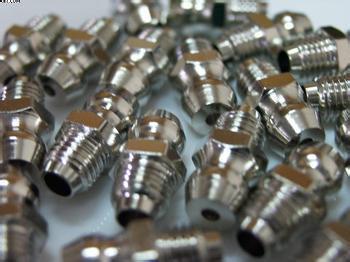How Do Nickel Cadmium Batteries Work
Applications of nickel
Nickel has good plasticity, corrosion resistance and magnetic properties, it is mainly used in the field of iron and steel, nickel base alloy, electroplating and batteries, widely used in aircraft, radar and other military manufacturing industry, civil machinery manufacturing industry and electroplating industry etc..
Iron and steel industry
Because nickel has better corrosion resistance, high temperature resistance, rust resistance and other properties, it is widely used in stainless steel and alloy steel and other steel fields.
Stainless steel
In stainless steel applications, nickel consumption is the largest, and global 2/3 primary nickel ore is used for the production of stainless steel. Corrosion of nickel containing stainless steel can resist air, steam and water, and the corrosion of acid, alkali and salt, so it is widely used in chemical, metallurgy, construction and other industries, such as the production of welded vessels, tower, tank, pipeline petroleum and chemical industry, textile, light industry, nuclear power and other industries; manufacturing production of urea synthesis tower, washing tower, cooling tower, corrosion resistance of high-pressure stripper and other equipment. According to the ratio of nickel, nickel containing stainless steel is mainly divided into austenitic stainless steel, austenitic ferrite duplex stainless steel, precipitation hardening stainless steel.

Alloy steel
Alloy steel is also called special steel. Because of its different composition, different kinds, the participation of nickel can improve the strength of the diamond, and maintain its good plasticity and toughness. Nickel containing alloy steel, is mainly used in the manufacture of acid towers, medical equipment, daily necessities, bridges, building warships and other machinery manufacturing in transportation and military industries.
Nickel based alloys
Nickel base alloy is a kind of alloy with high strength and certain resistance to oxidation and corrosion at high temperature of 650~1000 DEG C. According to the main properties, it can be divided into nickel based heat-resistant alloy, nickel based corrosion resistant alloy, nickel based wear-resistant alloy, nickel based precision alloy and nickel based shape memory alloy. Nickel based alloy products mainly include: electric stove, electric irons, turbine engine turbine disc, combustion chamber and turbine blades, color television, communication equipment, clock and measuring tape in the pendulum, furniture manufacturing, with permanent magnet performance fine tool. Nickel based alloys are widely used in aviation, shipping, chemical, electronic, medical and energy industries.
Electroplating field
Nickel plated refers to a durable corrosion-resistant coating covered the steel and other metal substrate, its corrosion resistance is higher 20% ~ 25% than galvanized layer. The nickel plated articles are beautiful, clean and difficult to rust. The processing capacity of electroplating nickel is only lower than electroplating zinc, and its consumption accounts for about 10% of the total output of nickel. Nickel plating is divided into chemical nickel plating and electroless nickel plating. The characteristics of electroless nickel plating are analyzed as follows:
Nickel plating
- nickel electroplating stability is very high in air, the crystallization is extremely small, and has excellent polishing performance, high hardness can improve the wear resistance of products surface, widely used in optical instruments, plating, decorative and protective coating, casting mold electronic components etc..

Electroless nickel plating
Electroless nickel plating has good thickness uniformity, no hydrogen penetration, no hydrogen embrittlement, electroless nickel plating without hydrogen removal. The corrosion resistance and oxidation resistance of electroless nickel plating on many products than the nickel plating, can be deposited on the surface of various materials, without the need for a DC motor control equipment or electroplating required, heat treatment temperature is low as long as the different holding time at 400 DEG C, can get different corrosion resistance and wear resistance, so that is especially suitable for complex shapes, surface wear resistance and corrosion resistance of parts of the functional coatings etc..
Nickel bath type
The types of nickel plating liquid mainly include sulfate type, chloride type, amino sulfonic acid type, citric acid salt type and fluorine borate type. Among them, the "sulfate type" (low chloride), that is called "Watts nickel plating liquid", is most commonly used in industry. Amino sulfonic acid and tin borate are suitable for thick nickel plating or electroforming. The citrate type is suitable for direct nickel plating on zinc die castings. The cost of plating bath is relatively high. Other common types include: nickel nickel (dark plating), bright nickel, nickel sulfamate, high sulphur, nickel sealing, satin nickel, high stress nickel, nickel plating layers and nickel citrate.
Battery field
Nickel plated metal has also been used in the field of batteries, mainly include nickel hydrogen batteries, nickel cadmium batteries, and nickel manganese batteries. They are mainly used in mobile communications, notebooks, video recorders, military, defense, high-tech and other fields.
The world's nickel hydrogen battery is made mainly by China and Japan enterprises, accounting for more than 95% of global output.
Other applications
Nickel composite material can be used in petroleum chemical hydrogenation and synthesis of methane.
Nickel compounds can be used to make pigments and dyes.
Very fine nickel powder, is often used as a catalyst in the chemical industry.









